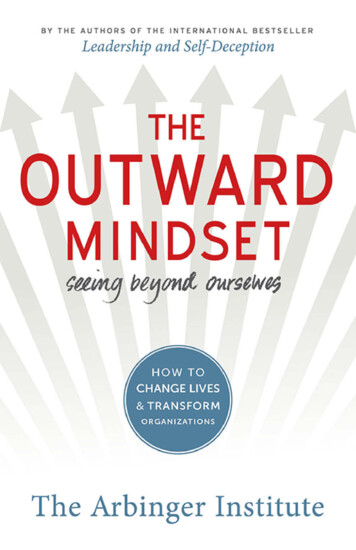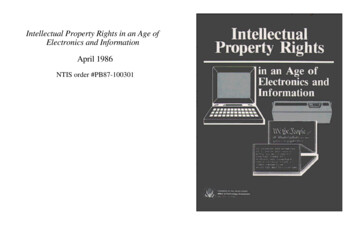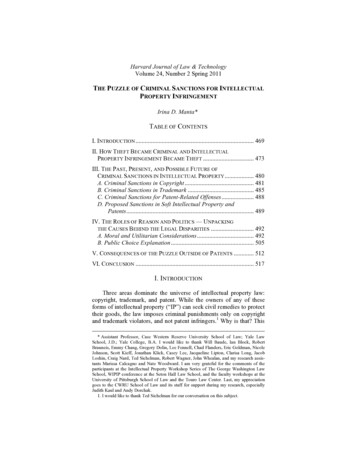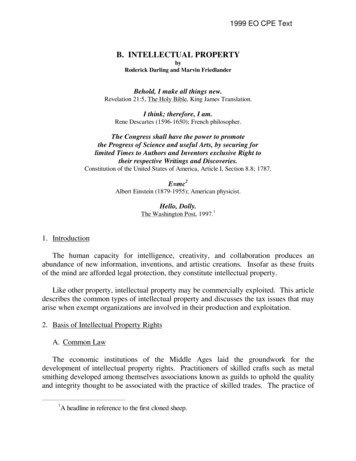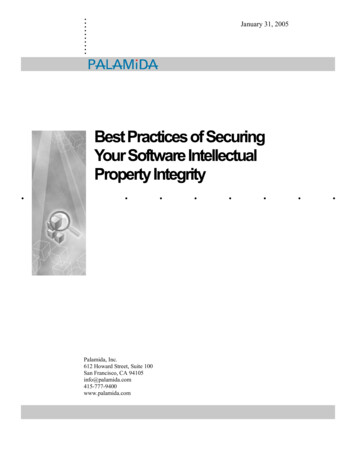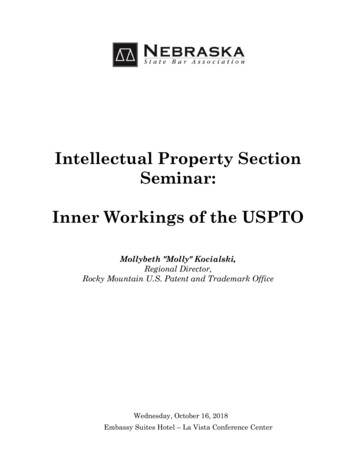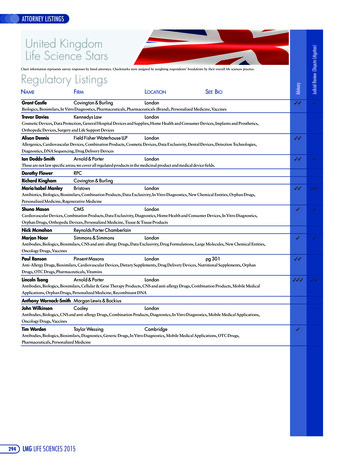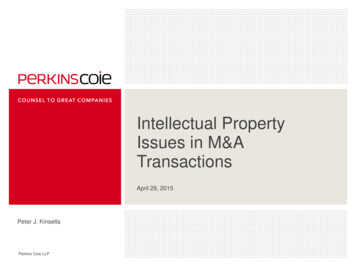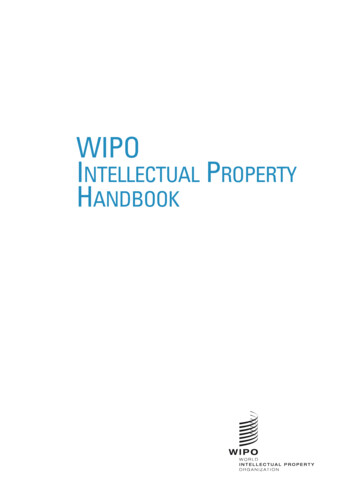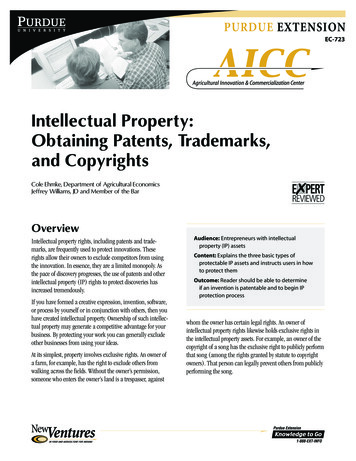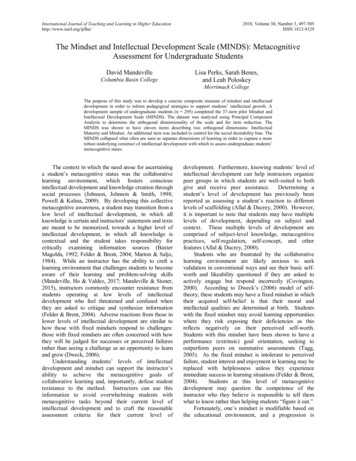
Transcription
International Journal of Teaching and Learning in Higher Educationhttp://www.isetl.org/ijtlhe/2018, Volume 30, Number 3, 497-505ISSN 1812-9129The Mindset and Intellectual Development Scale (MINDS): MetacognitiveAssessment for Undergraduate StudentsDavid MandevilleColumbia Basin CollegeLisa Perks, Sarah Benes,and Leah PoloskeyMerrimack CollegeThe purpose of this study was to develop a concise composite measure of mindset and intellectualdevelopment in order to inform pedagogical strategies to support students’ intellectual growth. Adevelopment sample of undergraduate students (n 295) completed the 37-item pilot Mindset andIntellectual Development Scale (MINDS). The dataset was analyzed using Principal ComponentAnalysis to determine the orthogonal dimensionality of the scale and for item reduction. TheMINDS was shown to have eleven items describing two orthogonal dimensions: IntellectualMaturity and Mindset. An additional item was included to control for the social desirability bias. TheMINDS collapsed what often are seen as separate dimensions of learning in order to capture a morerobust underlying construct of intellectual development with which to assess undergraduate students’metacognitive states.The context in which the need arose for ascertaininga student’s metacognitive status was the collaborativelearning environment, which fosters consciousintellectual development and knowledge creation throughsocial processes (Johnson, Johnson & Smith, 1998;Powell & Kalina, 2009). By developing this collectivemetacognitive awareness, a student may transition from alow level of intellectual development, in which allknowledge is certain and instructors’ statements and textsare meant to be memorized, towards a higher level ofintellectual development, in which all knowledge iscontextual and the student takes responsibility forcritically examining information sources (BaxterMagolda, 1992; Felder & Brent, 2004; Marton & Saljo,1984). While an instructor has the ability to craft alearning environment that challenges students to becomeaware of their learning and problem-solving skills(Mandeville, Ho & Valdez, 2017; Mandeville & Stoner,2015), instructors commonly encounter resistance fromstudents operating at low levels of intellectualdevelopment who feel threatened and confused whenthey are asked to critique and synthesize information(Felder & Brent, 2004). Adverse reactions from those inlower levels of intellectual development are similar tohow those with fixed mindsets respond to challenges:those with fixed mindsets are often concerned with howthey will be judged for successes or perceived failuresrather than seeing a challenge as an opportunity to learnand grow (Dweck, 2006).Understanding students’ levels of intellectualdevelopment and mindset can support the instructor’sability to achieve the metacognitive goals ofcollaborative learning and, importantly, defuse studentresistance to the method. Instructors can use thisinformation to avoid overwhelming students withmetacognitive tasks beyond their current level ofintellectual development and to craft the reasonableassessment criteria for their current level ofdevelopment. Furthermore, knowing students’ level ofintellectual development can help instructors organizepeer groups in which students are well-suited to bothgive and receive peer assistance. Determining astudent’s level of development has previously beenreported as assessing a student’s reaction to differentlevels of scaffolding (Allal & Ducrey, 2000). However,it is important to note that students may have multiplelevels of development, depending on subject andcontext. These multiple levels of development arecomprised of subject-level knowledge, metacognitivepractices, self-regulation, self-concept, and otherfeatures (Allal & Ducrey, 2000).Students who are frustrated by the collaborativelearning environment are likely anxious to seekvalidation in conventional ways and see their basic selfworth and likeability questioned if they are asked toactively engage but respond incorrectly (Covington,2000). According to Dweck’s (2006) model of selftheory, these students may have a fixed mindset in whichtheir acquired self-belief is that their moral andintellectual qualities are determined at birth. Studentswith the fixed mindset may avoid learning opportunitieswhere they risk exposing their deficiencies as thisreflects negatively on their perceived self-worth.Students with this mindset have been shown to have aperformance (extrinsic) goal orientation, seeking tooutperform peers on summative assessments (Tagg,2003). As the fixed mindset is intolerant to perceivedfailure, student interest and enjoyment in learning may bereplaced with helplessness unless they experienceimmediate success in learning situations (Felder & Brent,2004).Students at this level of metacognitivedevelopment may question the competence of theinstructor who they believe is responsible to tell themwhat to know rather than helping students “figure it out.”Fortunately, one’s mindset is modifiable based onthe educational environment, and a progression is
Mandeville, Perks, Benes, and Poloskeypossible towards the self-theory in which one believesthat one’s basic qualities can be developed acrosstime—the growth mindset (Dweck, 2000; Tagg, 2003).Students with the growth mindset often believe thatperceived failures are actually opportunities to cultivateknowledge. Students with this mindset have beenshown to have a learning (intrinsic) goal orientation,seeking to increase their capabilities across the longterm (Tagg, 2003). The belief that challenges, whenmet with effort and support, are an opportunity to elicitintellectual development allows students to sustainlearning in the midst of real-world situations ofambiguity and failure (Dweck, 2006).Thus,instructors’ ability to advance students’ intellectualdevelopment via the collaborative learning environmentis strongly connected to a student’s underlying selftheory or mindset.In order to advance students’ intellectualdevelopment and mindset, the learning environmentmust provide a meaningful challenge in which studentsare supported to do a task they could not doindependently but can accomplish with iterativeformative feedback (Wass & Golding, 2014). Creatingthis supportive classroom environment is based ondemonstrating respect for students at all levels ofintellectual development and recognizing that students’zones of proximal development also vary. Anotherimportant aspect of the respectful classroomenvironment is avoiding overwhelming students withtasks beyond their proximal zone of development byrealizing that students advance one ability level at atime. Within Vygotsky’s (2012) social constructivismtheory, the zone of proximal development describeslearning occurring when more capable peers orinstructors assist students to operate at a higher levelthan they could on their own. Over time, this classroomsupport enables students to learn to operateindependently at this new ability level. Thus, toeffectively advance students’ intellectual developmentby challenging the beliefs that characterize their currentlevel, an instructor must first understand and supportstudents’ current levels of intellectual development.The problem is that there are limited compositemeasures of mindset and intellectual developmentavailable to gauge a student’s current level ofmetacognitive development. The Motivated Strategiesfor Learning Questionnaire (MSLQ) by Pintrich, Smith,Garcia, and McKeachie (1993) is one popular sociocognitive measurement tool that brings together goalorientation, task value beliefs, control beliefs,perceptions of self-efficacy, and critical thinkingstrategies. The MSLQ is extensive and examines manycomponents of metacognition, but it does notincorporate mindset, or how malleable one believesone’s intelligence, personality, and other characteristicsto be. Therefore, our goal was to develop a conciseMetacognitive Assessment498composite measure of mindset and intellectualdevelopment to be used to identify students’metacognitive states. In addition to being a diagnostictool that can help instructors tailor content to students’intellectual development levels, this information couldbe used to chart undergraduate students’ progressiontowards achieving the metacognitive goals ofcollaborative learning and also to help instructors createmore productive peer work groups. Ideally, the variousinstructional uses of the MINDS will help instructorscoach their students on becoming life-long learnerswith growth mindsets.MethodSurvey AdministrationA development sample of undergraduate students,(n 295, mean age 20.2 2.5 years, female 70.7%,freshman 31.1%, sophomore 22.6%, junior 21.85%, senior 24.44%), were studied during theSpring Semester, 2017. Students were enrolled in theDepartment of Health Sciences at a midsizedcomprehensive college in the Northeast. Students whoenrolled in the study completed informed consentprotocols and the pilot Mindset IntellectualDevelopment Scale (MINDS) questionnaire during thefirst fifteen minutes of an undergraduate course offeredin the department. A member of the research teamproctored the data collection while the course instructorwas absent. Before completing the questionnaire,students were instructed to reply as accurately aspossible as their responses would remain anonymousand would not affect their course grade. Fourteenrespondents from the sample failed to complete thedemographic section of the MINDS; however, theirresponses were included into the data set.Survey CreationThe pilot MINDS questionnaire represented an initialattempt to condense and unify the underlying constructs ofmetacognition in higher education. These constructs hadpreviously been operationalized separately in onedimensional scales and included: mindset, intellectualdevelopment, goal orientation, and self-reflection. Each ofthese constructs was composed of multiple constructrelated items, or prompts. By combining these constructstogether, the initial item pool of the pilot MINDS included37-items (Figure 1a and 1b) in which the following stepswere followed for item selection.Step 1. Items were drawn from scales previouslyreported in peer-reviewed sources which hadsatisfactory validity and internal consistency. Themindset construct was comprised of eight items, fourdepicting each end of the continuum of the implicit
Mandeville, Perks, Benes, and PoloskeyMetacognitive Assessment499Figure 1a.The initial 20 items of the pilot MINDS; which were previously described as operationalizing constructs known toinfluence student metacognition: mindset (Dweck, 2006) and intellectual development (Baxter Magolda, 1992).theory of intellegence: entity (fixed) vs. incremental(malleable; Dweck, 2006). The mindset scale relating tointellegence was chosen as students’ implicit theories oftheir intelligence have been shown to predict resilience andacademic outcomes when they are faced with challengingwork (Blackwell, Trzesniewski & Dweck, 2007; Yeager &Dweck, 2012). Across 6 previously reported studies,measures of the implicit theory of intelligence have shown ahigh internal consistency (Cronbach’s alpha .94 - .98;Dweck, Chiu & Hong, 1995).The intellectual development construct wascomposed of twelve items, three for each of the fourstages of the continuum described by Baxter Magolda(1992). The four levels of intellectual developmentrepresent the construct of personal epistemologicalreflection as socially constructed and context-bound(Baxter Magolda, 2004). These levels of intellectualdevelopment emerged from an operationalizingscheme based on empirical data from more than 1,000undergraduate students (Baxter Magolda, 2004) andhave an internal consistency range of .62 - .82 (BaxterMagolda, 1988).The goal orientation construct consisted of tenitems, four each for the dichotomy (extrinsic vs.intrinsic) and one each depicting leadership andresponsibility (Pintrich et al., 1993).Thesemotivational items were based on the general socialcognitive model of motivation, specifically the valuecontructs which focus on the reasons why studentsengage academically. The intrinsic goal orientationitems represent a student’s focus on learning andmastery and have an internal consistency of .74, whilethe extrinsic goal orientation items represent a student’sfocus on grades and the approval of others and have aCronbach’s alpha of .62 (Pintrich et al., 1993).The self-reflection construct was composed ofseven items: four construct-related items (Aukes,Geertsma, Cohen-Schotanus, Zwierstra, & Slaets,2007), and three validity items depicting socialdesirability (Ballard, 1992) so as to control forresponses distorted by one’s desire to presentthemselves as socially agreeable (Devellis, 2016). Selfreflection was described as the introspective appraisalof experience occurring as a prerequisite for reframing
Mandeville, Perks, Benes, and PoloskeyMetacognitive Assessment500Figure 1b.The remaining 17 items of the pilot MINDS; which were previously described as operationalizing constructs knownto influence student metacognition: goal orientation (Pintrich et al., 1993) and self-reflection (Aukes et al., 2007).one’s beliefs (Aukes, Geertsma, Cohen-Schotanus,Zwierstra, & Slaets, 2007). The social desireabilitybias is understood as the tendency in self reports topresent oneself in the best possible light at the expenseof accurate reporting. The internal consistency for theself-reflection construct items has been reported torange from .83 - .74 (Aukes, Geertsma, CohenSchotanus, Zwierstra, & Slaets, 2007). The short formMarlowe-Crowne social desirability items’ internalconsistency has been reported to be .70 (Ballard, 1992).Step 2. Each item was operationalized by assigninga five point Likert Scale (1 strongly disagree, 5 strongly agree) to the prompt so that students could ratehow important the item was to their course work.Step 3: The items were randomized and then dividedinto fou
influence student metacognition: mindset (Dweck, 2006) and intellectual development (Baxter Magolda, 1992). theory of intellegence: entity (fixed) vs. incremental (malleable; Dweck, 2006). The mindset scale relating to intellegence was chosen as students’ implicit theories of their intelligence have been shown to predict resilience and academic outcomes when they are faced with challenging .
